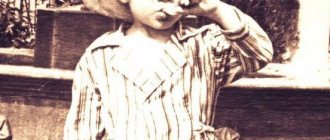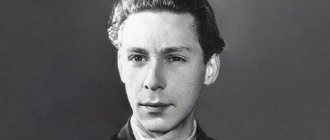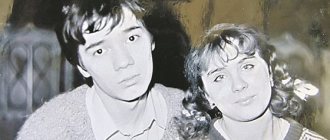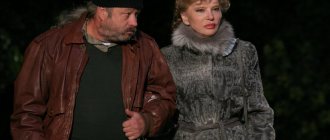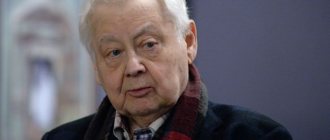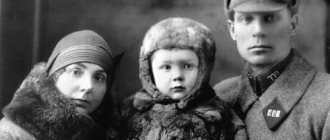Biography
Oleg Popov is a Soviet clown, a student of the legendary Pencil, who during his career managed to conquer the international arena. Queen Elizabeth II of England herself applauded him; streets named after him appeared in Munich and Brussels. In the Guinness Book of Records he is listed as the most popular clown on the planet. In addition, he has several films to his credit. The artist starred in the films “The Adventures of the Yellow Suitcase”, “Mom”, “Blue Bird” and others.
Childhood and youth
Oleg Konstantinovich Popov was born on the last day of July 1930 in the village of Vyrubovo, Kuntsevo district, Moscow region, which currently belongs to the urban settlement of Odintsovo. Soon his parents were given an apartment in the capital, not far from the Dynamo stadium. Oleg Popov's father worked at a watch factory. At the end of the 30s, he was arrested and went to prison, and his mother married another man and changed her last name.
Oleg Popov in his youth / Wikipedia
Oleg's family barely made ends meet, so the boy went to work early. During his first years, he sold soap at the market, which was illegally brewed by his neighbor. As a 12-year-old teenager, Popov got a job at the printing plant of the Pravda newspaper as an assistant mechanic. During the war, people had to starve, and Oleg did not have enough to eat. One day the boy became so weak that he almost died; his mother could hardly leave her son. After this incident, it was decided to send the teenager to the sports section.
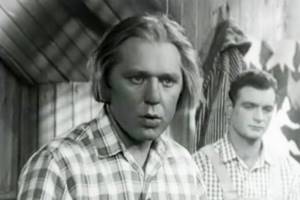
Oleg Popov without makeup (still from the film “Clubfooted Friend”)
This is how Oleg Popov got into the acrobatics club at the Wings of the Soviets Sports Palace. During classes, it became clear that many things were easier for the boy than for others. Once upon a time, the head of a circus school drew the attention of a flexible and resilient guy, inviting him to take the entrance exams. A compelling argument in favor of choosing an educational institution were bread cards: college students were entitled to 100 g of bread more than a factory worker.
In 1944, Popov went to study at the State School of Circus Arts. The future artist graduated from this educational institution after 5 years, his specialty was “eccentric on a wire.” During his studies, the artist mastered various circus techniques, which he later used when performing in the arena: juggling, elements of acrobatics and balancing act.
Born on July 31, 1930 in the village of Vyrubovo, Moscow Region. Soon Oleg's parents moved to the center of the capital. Dad worked as a watchmaker, mom was a photographer. My father was arrested after he made a watch for Stalin, but it stopped working. The family never saw their breadwinner again and learned nothing about where and under what circumstances he died. All his life Oleg carried this pain within himself.
During the war, as an eleven-year-old teenager, Oleg began working: first he sold soap, and then became an apprentice mechanic at the Pravda printing plant. The time was hungry and cold, Oleg was often malnourished, sick, and once almost died, he was so weak. The mother and the neighbor had difficulty getting the boy out. Oleg was advised to play sports, he signed up for the sports section at the Pravda newspaper. It turned out that many things came easier to him than to others. The head of the circus school noticed the guy’s flexibility, jumping ability and endurance and invited Oleg to join them. At the school, Oleg began a new life, he found himself. He absolutely loved everything he was taught: juggling, rope and trapeze exercises, and pantomime. Mom did not immediately approve of her son’s choice to be an artist; she only got used to it over time. Oleg made his debut as a tightrope walker.
His professional life was turned upside down by chance. A circus colleague fell ill, Oleg was asked to replace him, and he began to improvise like a real clown. The success among the audience was enormous, as if the performance had been prepared for a long time and carefully. From that moment on, Oleg began to come up with his own clown program. In the 50s, Popov began assisting the famous clown Karandash, it was a very fruitful collaboration, it allowed Oleg to develop a unique image of his red-haired clown in striped pants, who, less than a year later, was talked about as the best clown in the country. Oleg Popov, together with the Soviet circus team, traveled around the world on tour. He met Charlie Chaplin, and this was the greatest happiness for him. The artist was married to a violinist in a circus orchestra; she gave Oleg his only daughter, Olga. When she grew up, she began to work with her father.
In the Soviet Union, Oleg Popov worked in the circus, on television, and acted in films. Every Soviet person knew and loved him. Already in adulthood, Popov moved to live in Germany. After the death of his first wife, he tied the knot with a young German circus performer. In Germany, the great clown worked under the pseudonym “Happy Hans.”
Circus
In his youth, after graduating from circus school, Oleg Popov was assigned to the Tbilisi Circus. There he began his career as an artist as a tightrope walker-comedian, and after 2 months he returned to Moscow. Until 1953, he assisted the famous master of the comic genre Karandash at the circus on Tsvetnoy Boulevard. The place of the master’s assistant had previously been occupied by Yuri Nikulin, but after a conflict with the director, the star of “Prisoner of the Caucasus” had to release him.
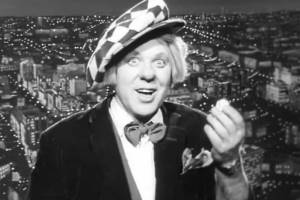
Clown Oleg Popov (still from the film “The Highest”)
In 1954, a fateful incident occurred in the artist’s creative biography. Popov had to replace Pavel Borovikov, a circus colleague who broke a rib on the eve of the performance. The young clown improvised, imitating a juggler, manipulating forks, spoons and frying pans. The success was stunning, and after this act his role as a carpet clown was finally formed, who was recognized by his bright striped pants and original headdress - a checkered cap.
Since the mid-1950s, Oleg Popov actively toured abroad and directed circus performances. After performing in Great Britain in 1968, he acquired the nickname Sunny Clown. In the 1970s he worked at the Great Moscow State Circus on Vernadsky Boulevard. His most successful and audience-favorite reprises were “Cook”, “Sleep on a Wire”, “Drowned Man”, “Whistle”, “Ray”.
Oleg Popov - “Cook”
Cooperation with the circus on Tsvetnoy Boulevard did not work out. Yuri Nikulin, being its director, for unknown reasons did not invite Oleg Popov to the famous arena. After the death of the comedian in 1997, the Sunny Clown, in a conversation with reporters, expressed bewilderment at the fact that Maxim Nikulin, who had not previously participated in circus life, became the head of the creative team.
In the early 1990s, the artist, dejected by the lack of prospects and low income, immigrated to Germany, while retaining Russian citizenship. After the move, he did not leave his career. In the city of Eglofstein, Popov began working as a clown under the stage name Happy Hans.
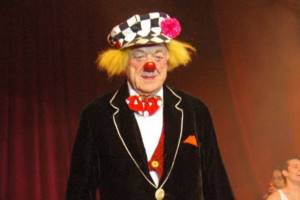
Clown Oleg Popov / Patrick Glanz, Wikipedia
The actor's talent manifested itself not only in the performing arts. Oleg Konstantinovich became interested in music. Since the late 90s, Popov has recorded several comic works: “Song about the Circus”, “Song about Repairs”, “Open Your Eyes”. The musical compositions were included in the author's collection of children's songs.
In June 2015, after more than two decades living abroad, the famous Oleg Popov visited his homeland. He delighted with his performance the audience gathered at the Sochi circus for the International Professional Circus Award “Master”. The talent of the Sunny Clown was awarded in the “Circus Legend” category. As Popov later recalled, in Russia a crowd of fans was already waiting for him at the airport, something the artist never expected to see. Fans of the great comedian's work recognized him even without makeup and a wig.
Place in life
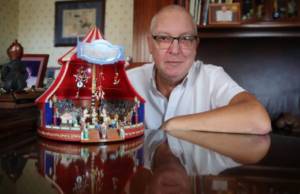
"There are no young clowns"
Director of the Circus on Tsvetnoy Boulevard Maxim Nikulin - about Soviet traditions in the arena, the revival of old genres and accusations of "Peacemaker"
Among the entertainment available to Soviet people, the circus occupied an intermediate place between cinema and theater. The first one was widespread (at least in the form of moving films), and people could “go into” the cinema. The theater was an event that required expenses, a dress code, and even a trip to another city. In addition, the theater could be boring - even for adults, not to mention children. There was never a dull moment at the circus. People dressed up there too, but it was a family, simple outing - with soda (not cognac) in the buffet, understandable impressions and understandable emotions. People first of all went to the circus for emotions - it didn’t matter whether it was the Old Circus on Tsvetnoy Boulevard in Moscow or the summer tent in the regional center.
It’s clear who is in charge of emotions in the circus. Huge boots and a round foam nose, clumsy falls and shooting with a water pistol. Children always think that the clown in the program has an annoyingly short time.
Of all the circus crafts, clowning is the least obvious, the least accurately described in the meager lines of professional standards. “Brings ten lions to the arena”, “jumps without a safety net from under the dome five times in the evening”, “rides a unicycle blindfolded backwards, juggling eight bricks”, “saws two assistants lengthwise and crosswise at the same time” - that’s all It's clear. But how to describe the success of a clown? Was there 12 decibels of laughter today? 6% more boys and girls left the hall with tears of happiness in their eyes? What is this “great clown” anyway?
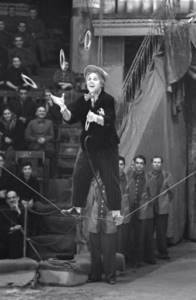
Photo: RIA Novosti/Alexander Cheprunov
Oleg Popov during a performance at the Moscow Circus on Tsvetnoy Boulevard, 1956
Oleg Popov grew up in the capital, in the Petrovsky Park area. During the war and early post-war times, it was no longer quite the outskirts of Moscow, but far from being the center. Everything was “their own” here. Its own industry (at the Pravda printing house, 13-year-old Oleg worked as a mechanic’s apprentice), its own sports infrastructure (in the small sports palace “Wings of the Soviets” hidden in the courtyards of Leningradsky Prospekt, he practiced acrobatics), its own educational institution - unique even on a global scale.

“I want fools who are always happy to teach smart people”
People's Artist of Russia Slava Polunin - about the wisdom of clowns, the formula of harmony and the wings behind your back
The circus school is still located in the same place where it was in 1944 - on Yamsky Field. A plastic, naturally flexible young man graduated from circus school in 1950. No, his diploma did not contain the word “clown” (although clowns were always taught here). Popov's first specialty is an eccentric on a wire. However, it’s not even half a step from here to clowning.
Movies
When fame came to Oleg Popov, he began appearing in television programs. In addition, the artist played in more than 10 films. The success of the young clown was so great that his circus act was included in the documentary “Arena of the Brave” (1953). This work became his film debut.
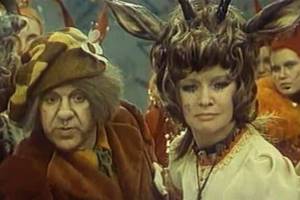
Oleg Popov and Lyudmila Gurchenko (still from the film “Mama”)
The most famous films with his participation were “Clubfooted Friend” (1959), “The Last Crook” (1966), “The Adventures of the Yellow Suitcase” (1970), “Carnival” (1972), “Mom”, “Blue Bird” (1976) , “Trespassers Allowed to Enter” (1987). Most often, the artist played himself in films, appearing in his famous checkered cap, which was an invariable attribute of his image.
Personal life
For a long time, the artist’s personal life was connected with the name of one woman. In 1950, Oleg Popov got married for the first time. His chosen one was called Alexandra, she was a violinist in a circus orchestra. Popov’s wife gave birth to a girl, Olga, who at the age of 13 decided to follow in her father’s footsteps and subsequently also became a circus high-wire dancer. Now the daughter of the legendary clown lives near Frankfurt. After starting a family and having children, she left her circus career. Oleg Popov has a grandson Evgeniy, a granddaughter Vera and a great-grandson Maximilian.
“Alone with everyone” - Oleg Popov
In 1990, Popov's wife died of cancer. For the last 10 years of her life, she had to struggle with an illness; she no longer accompanied her husband on tour and lived in Moscow. At the time of Alexandra Ilyinichna’s death, Oleg Popov was performing in Hamburg and, as a result of the impresario’s persuasion, did not interrupt his tour to go to say goodbye to his wife.
In 1991, Oleg Popov married for the second time. His wife was Gabriele Lehmann, a German by nationality who is 32 years younger than the clown. They met during a performance of the Russian State Circus. The girl came to the event as a spectator, she did not have enough space and had to watch the performance in the aisle.
View this post on Instagram
A post shared by Kostyukova Elizaveta (@lks210) on Nov 3, 2016 at 11:19am PDT
Oleg Popov in recent years
Speaker Popov noticed a standing girl and brought her a chair. Then Gabi came to thank the artist - their chance acquaintance grew into true love, despite the language barrier. The artist’s wife also entered the arena - she quit her job at the pharmacy and began helping Oleg Konstantinovich at his performances. The couple lived in Germany.
Oleg Konstantinovich devoted his free time to animals. On the site where the artist’s mansion stood, he had ponies, pigeons, dogs and rabbits. He never learned German, but communicated with his wife in Russian.
Death
On November 2, 2021, Oleg Popov died of cardiac arrest. The death of the 86-year-old legendary clown occurred in Rostov-on-Don. He came there with a new program “Let There Always Be Sunshine” as part of an all-Russian tour.
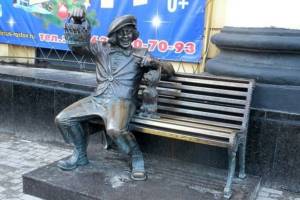
Monument to Oleg Popov in Rostov-on-Don / Lipunov G.A., Wikipedia
The next day, a funeral service took place in the Church of John of Kronstadt in Rostov-on-Don and a civil funeral service in the city circus. The master's grave is located in the German city of Eglofstein. Instead of the usual monument with a photo, there is a monument with a sculpture of Oleg Popov looking out from behind the curtain.
Quiet family life
The couple lived near Nuremberg, in the town of Eglofstein. Oleg Konstantinovich never mastered the German language perfectly, but his wife learned Russian. It was Gabrielle who dealt with all organizational issues. The only thing that connected the legendary clown with his homeland was his Russian citizenship, which he never exchanged for German, although, being married to a German woman, he could have easily done this. In 2015, for the first time after 24 years of living in Germany, Oleg Popov visited Russia. The master performed at the Sochi circus with two reprises as part of the International Professional Circus Award “Master”.
***
Oleg Popov died at the age of 87 in Rostov-on-Don on November 2, 2021, where he was on tour. The artist was buried in Germany. In 2021, a monument to the artist was unveiled in Rostov-on-Don, next to the building of the Rostov State Circus.
